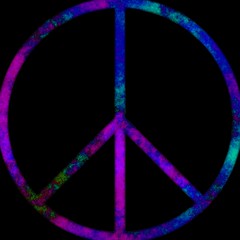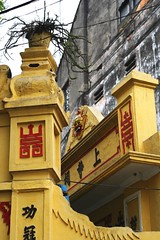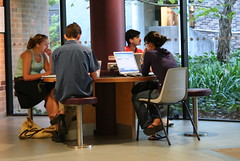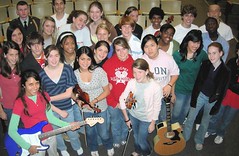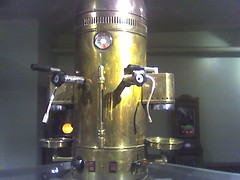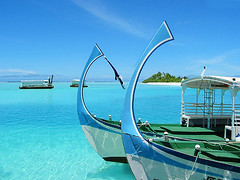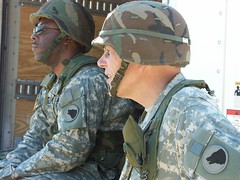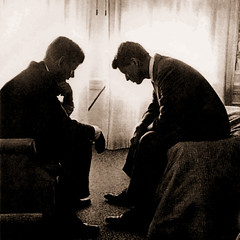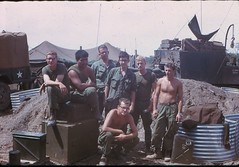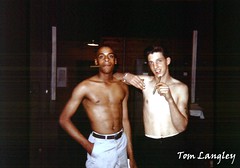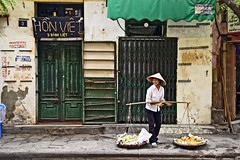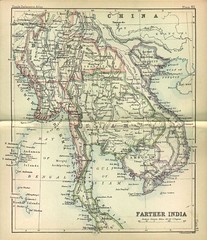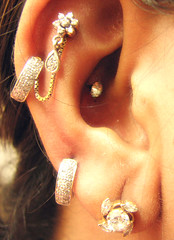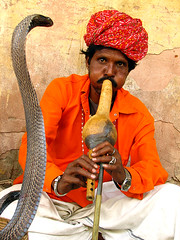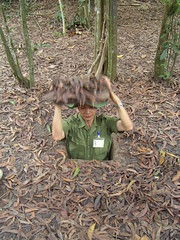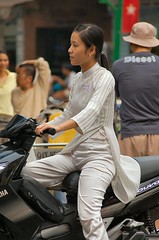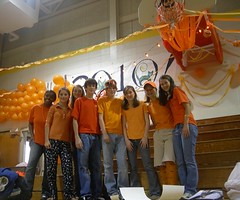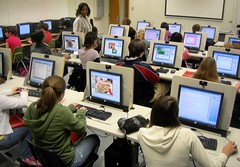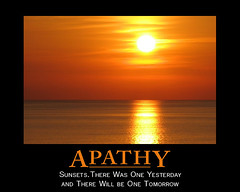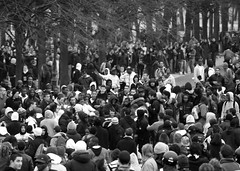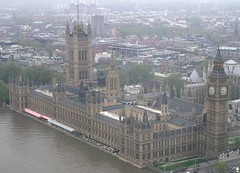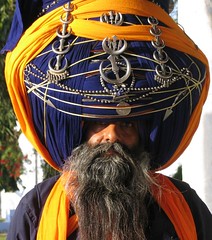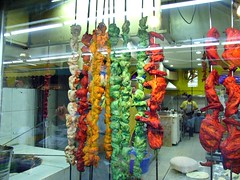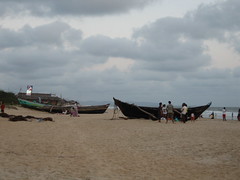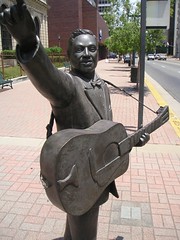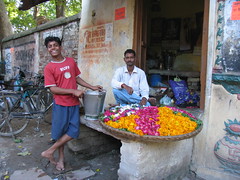Thursday, November 30, 2006
The Peace Symbol originated in Britain during the 1950's anti-nuclear weapons protests
One of the most widely known symbols in the world, in Britain it is recognised as standing for nuclear disarmament – and in particular as the logo of the Campaign for Nuclear Disarmament (CND). In the United States and much of the rest of the world it is known more broadly as the peace symbol. It was designed in 1958 by Gerald Holtom, a professional designer and artist and a graduate of the Royal College of Arts.
This background, from a site with the UC Berkely library , also says:
The symbol almost at once crossed the Atlantic. Bayard Rustin, a close associate of Martin Luther King had come over from the US in order to take part in that first Aldermaston March. He took the symbol back to the United States where it was used on civil rights marches. Later it appeared on anti-Vietnam War demonstrations and was even seen daubed in protest on their helmets by American GIs. Simpler to draw than the Picasso peace dove, it became known, first in the US and then round the world as the peace symbol. It appeared on the walls of Prague when the Soviet tanks invaded in 1968, on the Berlin Wall, in Sarajevo and Belgrade, on the graves of the victims of military dictators from the Greek Colonels to the Argentinian junta, and most recently in East Timor.
What happened to the US in Vietnam: an essay due Tues, Dec 5
This week we will culminate our study of Vietnam and the Vietnam conflict by composing a brief essay. Due Tues, the essay will be based on the 5 presidents Timeline and other notes.
Please attend to ...
- Snammy title.
- explanatory subtitle.
- colorful opening.
- logical order.
- specific examples (ie, "It was the longest war in US history." Make sure you add "US troops were involved on Vietnamese soil from 1954 to 1975."
- documentation: use "according to ..." in first paragraph.
In class we will write an outline and draft. At home students will be expected to write and type the 1-page essay.
15 pts.
Please attend to ...
- Snammy title.
- explanatory subtitle.
- colorful opening.
- logical order.
- specific examples (ie, "It was the longest war in US history." Make sure you add "US troops were involved on Vietnamese soil from 1954 to 1975."
- documentation: use "according to ..." in first paragraph.
In class we will write an outline and draft. At home students will be expected to write and type the 1-page essay.
15 pts.
A laptop for Christmas? I recommend it for your strongest consideration
Not all parents will understand or agree with my recommendation of a laptop-type computer for Xmas, but you might hear me out.
1) The mobility of a laptop means you can take your work with you on errands and trips and while waiting. Many CMHS students sit beside the building and use the Caddo wireless signal before and after school.
2) I believe that students who use them in the classroom may get more out of the class period. Students can use them to take notes, compose essays, keep their assignments and aid the teacher by researching impromptu definitions and background info. The teacher will monitor their use by visually checking the student screen. If students go off task regularly the teacher may ask the student to forego laptop use for a certain amount of time.
3) Portable computers allow the family to work together. If Dad is making supper, the student can do homework in the kitchen. If Mom is relaxing with a magazine, the student can pursue their work nearby. Parental overview is one of the keys to success.
4) A wireless router, about $50, is a key to round-the-house laptop usability.
5) Laptops have fallen in price. The computer market is becoming saturated and computer companies have to be aggressively competitive.
6) Laptops can give parents a bargaining tool. The leverage point can become, "If you do this much work, I'll allow you this much personal computer time."
The idea is certainly worth investigating and debating.
Looking at an alternative student present? A digital camera with 512 mb memory card will be most useful at school and home.
1) The mobility of a laptop means you can take your work with you on errands and trips and while waiting. Many CMHS students sit beside the building and use the Caddo wireless signal before and after school.
2) I believe that students who use them in the classroom may get more out of the class period. Students can use them to take notes, compose essays, keep their assignments and aid the teacher by researching impromptu definitions and background info. The teacher will monitor their use by visually checking the student screen. If students go off task regularly the teacher may ask the student to forego laptop use for a certain amount of time.
3) Portable computers allow the family to work together. If Dad is making supper, the student can do homework in the kitchen. If Mom is relaxing with a magazine, the student can pursue their work nearby. Parental overview is one of the keys to success.
4) A wireless router, about $50, is a key to round-the-house laptop usability.
5) Laptops have fallen in price. The computer market is becoming saturated and computer companies have to be aggressively competitive.
6) Laptops can give parents a bargaining tool. The leverage point can become, "If you do this much work, I'll allow you this much personal computer time."
The idea is certainly worth investigating and debating.
Looking at an alternative student present? A digital camera with 512 mb memory card will be most useful at school and home.
Wednesday, November 29, 2006
Class of 2010 talent Show
Please enjoy the show on Fri, Dec 1, 7 pm, PAC at CMHS. bring your friends. $5.
The significant stimulation of a tiny shot of espresso
Espresso (Italian) is a concentrated coffee beverage brewed by forcing very hot, but not boiling, water under high pressure through coffee that has been ground to a consistency between extremely fine and powder. It was invented and has undergone development in Milan, Italy since the beginning of the 20th century, but up until the mid 1940s it was a beverage produced solely with steam pressure. The invention of the spring piston lever machine and its subsequent commercial success changed espresso into the beverage we know of today, produced with between 9 and 10 atmospheres of pressure.
Wikipedia.com
Wikipedia.com
The global peregrinations of the potable known as Qahwah, or Coffee
An outline of the history of the spread of coffee (qahwah, Arabic):
1. Ethiopian origins.
2. Mocha, Yemen.
3. Arabian peninsula and nearby nations such as Turkey & Egypt.
4. Europeans
- coffee houses in London, Amsterdam, Vienna & Paris were centers for writers and thinkers in 1700's.
5. Spread of coffee cultivation via the European colonies.
6. Java, Indonesia and other Asian nations, such as India and Vietnam.
7. East Africa, ex. Kenya.
8. Brazil (largest crop in the world) and other South American nations such as Colombia.
9. Caribbean nations such as Jamaica.
Italian terms:
- espresso
- cappucino
- latte
- barista
French:
- frappe
- demi-tasse
- cafe au lait
Spanish:
cafe con leche
1. Ethiopian origins.
2. Mocha, Yemen.
3. Arabian peninsula and nearby nations such as Turkey & Egypt.
4. Europeans
- coffee houses in London, Amsterdam, Vienna & Paris were centers for writers and thinkers in 1700's.
5. Spread of coffee cultivation via the European colonies.
6. Java, Indonesia and other Asian nations, such as India and Vietnam.
7. East Africa, ex. Kenya.
8. Brazil (largest crop in the world) and other South American nations such as Colombia.
9. Caribbean nations such as Jamaica.
Italian terms:
- espresso
- cappucino
- latte
- barista
French:
- frappe
- demi-tasse
- cafe au lait
Spanish:
cafe con leche
5 presidents timeline project to be followed by Veteran Interview
Most students have done a terrific job of summarizing the bios of the 5 presidents associated with the Vietnam conflict. Most have succesfully integrated terms from general knowledge of the army and war, such as guerilla warfare (French: guerre, "war, therefore, guerilla, "little war").
Truman: inherited the presidency and the decision of whether to drop the A bomb. Reasoned that it would ultimately save lives by bringing a quicker end to the war.
Eisenhower: 5-star general whose strategy helped defeat Hitler. As president, defined the Cold War as a mostly covert struggle against communism and communism's Domino Effect.
JFK: was able to out-poll the experienced leader Richard Nixon by virtue of his youthful good looks in the first televised presidential debate, 1960. Very slim margin of victory, reminding us of the Bush Vs. Gore election. JFK assassinated in 1963.
Lyndon Johnson: became president upon JFK's death. Used Gulf of Tonkin Resolution to make war against the North Viet communists.
Continually raised troop strength over several year period but could not produce a victory. His team thoroughly underestimated the enemy (sound familiar, as in Iraq?).
Using the draft to fill the ranks of the Army, incurred the wrath of the student protest movement. Demonstrations against the war - doves vs. hawks - grew from campus activity to large-scale marching in cities. Culminated with March on Washington (250,000 participants) in 1968.
Troop deployment in Vietnam peaks in '68 at some 500,000. The NVA & VC make a dramatic victory in '68 by a large-scale, surprise attack against our strongholds. Called the Tet Offensive, it marks a turning point in the war.
Richard Nixon: determined to best the communists Nixon used heavy bombing of North Vietnam to gain an advantage. Somehow, Ho Chi Minh's forces held out. Overall, Nixon managed the US exit from 'Nam. he also won praise by opening trade with communist China, at the time a backwards nation and "sleeping giant."
Nixon resigned in '74 due to the Watergate Scandal.
He and his aides had denied involvement in various "dirty tricks" against the Democrats in the election of '68. Journalists kept the inquiry alive and after several years of determined reporting, found the evidence that Nixon had known about the chicanery of his re-election team. When the US public learned that the president had lied about his involvement, Nixon lost the nation's support. he resigned rather than face impeachment.
Truman: inherited the presidency and the decision of whether to drop the A bomb. Reasoned that it would ultimately save lives by bringing a quicker end to the war.
Eisenhower: 5-star general whose strategy helped defeat Hitler. As president, defined the Cold War as a mostly covert struggle against communism and communism's Domino Effect.
JFK: was able to out-poll the experienced leader Richard Nixon by virtue of his youthful good looks in the first televised presidential debate, 1960. Very slim margin of victory, reminding us of the Bush Vs. Gore election. JFK assassinated in 1963.
Lyndon Johnson: became president upon JFK's death. Used Gulf of Tonkin Resolution to make war against the North Viet communists.
Continually raised troop strength over several year period but could not produce a victory. His team thoroughly underestimated the enemy (sound familiar, as in Iraq?).
Using the draft to fill the ranks of the Army, incurred the wrath of the student protest movement. Demonstrations against the war - doves vs. hawks - grew from campus activity to large-scale marching in cities. Culminated with March on Washington (250,000 participants) in 1968.
Troop deployment in Vietnam peaks in '68 at some 500,000. The NVA & VC make a dramatic victory in '68 by a large-scale, surprise attack against our strongholds. Called the Tet Offensive, it marks a turning point in the war.
Richard Nixon: determined to best the communists Nixon used heavy bombing of North Vietnam to gain an advantage. Somehow, Ho Chi Minh's forces held out. Overall, Nixon managed the US exit from 'Nam. he also won praise by opening trade with communist China, at the time a backwards nation and "sleeping giant."
Nixon resigned in '74 due to the Watergate Scandal.
He and his aides had denied involvement in various "dirty tricks" against the Democrats in the election of '68. Journalists kept the inquiry alive and after several years of determined reporting, found the evidence that Nixon had known about the chicanery of his re-election team. When the US public learned that the president had lied about his involvement, Nixon lost the nation's support. he resigned rather than face impeachment.
Saturday, November 25, 2006
Soldier interview: it is history and you are a historian in the Viet vet project
Hello Mr. T.
Hope you are having a great break. Can you tell me what I need to do for the interview? I think I should summarize what the veteran said for each question and my mom won't let me. She is making me quote him for the whole thing.
This guy talked for about 2 hours or more. This project would take more than 5 hours to do my mom's way. She said I can take out the portions where he got long winded but she wants me to include all of the other stuff.
I want to summarize any interesting stories he told but not quote him. Which do you want me to do?
Thanks for the help. Hope you can save me some time!
J,
Thanks for asking! That's the mark of an intelligent writer.
My guideline is Treat your interview like History. It is. It's a primary source. The value in it is the interviewee's actual words.
There's nothing academically wrong with summarizing as long as you have first transcribed verbatim. The guideline on our web site says to write out the Q & A, which means the actual words. I agree that some of his longwindedness might be omitted.
Who knows when you'll go back to this material - perhaps years from now - on some project. You'll be happy to see the actual transcript.
RT
Friday, November 24, 2006
Viet vet interview: substituting a Korean War vet or WWII in Pacific vet
If the problems in finding a Vietnam war veteran seem too great, you may substitute:
* Korean War vet - please see World Book or another source for background before conducting the interview.
* WWII in the Pacific vet - please see an encyclopedia or other summary before the interview. The vet will - rightly - expect you to kow something about this war!
* Korean War vet - please see World Book or another source for background before conducting the interview.
* WWII in the Pacific vet - please see an encyclopedia or other summary before the interview. The vet will - rightly - expect you to kow something about this war!
Vietnam is cool: Jolie & Pitt jazz around Ho Chi Minh City on scooter
HANOI (Reuters) - Hollywood superstars Brad Pitt and Angelina Jolie made a surprise visit to Vietnam, cruising the streets of commercial hub Ho Chi Minh City on a motorbike.
Photos of the couples on a grey scooter appeared on the front pages of state-run newspapers on Friday, puzzling some Vietnamese who had never heard of them before.
"I saw the pictures in the newspaper but still have no idea why the fuss about these Westerners," Nguyen Van Thu, a construction worker in Hanoi, said. "But now maybe I will watch their movies to know why."
Pitt and Jolie arrived in Vietnam on Thursday during what appeared to be a break from filming "A Mighty Heart" in India, where they have been mobbed by fans and stirred a media frenzy.
The film stars Jolie as the wife of U.S. journalist Daniel Pearl, who was abducted and murdered by Islamic militants in Pakistan in 2002. Pitt is the producer.
State newspapers said the couple flew into Vietnam on Thursday from Cambodia, the birthplace of their adopted son Maddox. They were seen dining at a Vietnamese restaurant undisturbed and were due to return to Cambodia on Friday.
Thursday, November 16, 2006
Five Presidents, the Cold War and Vietnam
Informal timeline project
- 10 pts.
- brief notes.
- due Tues, Nov 28
- on paper or via digital presentation.
Include -
5 presidents' images, dates & brief bios
and brief descriptions of 5 of the following (between the presidents entries):
Geneva Accord
Gulf of Tonkin Resolution
Ho Chi Minh
guerilla warfare
Anti-war protest movement
NVA & VC in Tet Offensive
Counterculture movement
My Lai village massacre
Vietnamese refugees: "boat people"
Mekong River
Armaments of the conflict
My students may make creative decisions regarding the style and format of presenting these facts. The goal is to give you an overview before you meet your veteran for the primary source interview.
Wednesday, November 15, 2006
Viet map project: All eyes on 'Nam, 1950 - 1975
All Eyes on 'Nam, 1950 - 1975
On a sketch of world map (see pp 2 - 3) please
a) put a rim of color around the following nations, all involved in the Vietnam conflict.
b) draw arrows from the nations to Vietnam
c) along the arrow/line add a brief explanation of that nation's role in the war.
d) add an original title.
5 pt. project
France - controlled Indochina from 1840's to 1954
NYC - HQ of the United Nations; UN splits Vietnam into 2 nations, North and South, in 1954.
USA - Fights against spread of communism by N Vietnam.
Australia - ally of US that sends troops.
New Zealand - ally who sends troops.
Canada - ally who sends troops to 'Nam.
China - guns & money to N Vietnam
Russia - guns & money to N Viets
On a sketch of world map (see pp 2 - 3) please
a) put a rim of color around the following nations, all involved in the Vietnam conflict.
b) draw arrows from the nations to Vietnam
c) along the arrow/line add a brief explanation of that nation's role in the war.
d) add an original title.
5 pt. project
France - controlled Indochina from 1840's to 1954
NYC - HQ of the United Nations; UN splits Vietnam into 2 nations, North and South, in 1954.
USA - Fights against spread of communism by N Vietnam.
Australia - ally of US that sends troops.
New Zealand - ally who sends troops.
Canada - ally who sends troops to 'Nam.
China - guns & money to N Vietnam
Russia - guns & money to N Viets
Tuesday, November 14, 2006
Why photos of Vietnam soldiers look the way they do . . .
Things to remember as you view photos of Vietnam in the 1960's:
a) Soldiers were not trained as photographers.
b) Photos fade with the decades.
c) 'Nam is in the Tropics; look at the latitude. It also rained a lot.
d) Soldiers were often 18 - 20 years old. They were proud of their Army-toughened physique.
e) Cigarettes' relationship to heart disease and cancer was not clear.
f) Soldiers were marooned in Oz. Life in war was mysterious and brutal. Soldiers often responded by acting goofy.
g) Vietnam has denuded by war and revamped by the construction of large US installations.
h) Entertainment technology: record players. There were also reel-to-reel tape recorders. No TV.
i) Dear John letters were common. That means your wife back in the states has decided to ask for a separation or divorce.
j) In the states there was a youth revolution occuring. College kids were tripping out. At least in 'Nam there was plenty of beer, cheap dope and hooch girls.
k) By 1970 almost everyone began to have serious doubts about our course of action.
a) Soldiers were not trained as photographers.
b) Photos fade with the decades.
c) 'Nam is in the Tropics; look at the latitude. It also rained a lot.
d) Soldiers were often 18 - 20 years old. They were proud of their Army-toughened physique.
e) Cigarettes' relationship to heart disease and cancer was not clear.
f) Soldiers were marooned in Oz. Life in war was mysterious and brutal. Soldiers often responded by acting goofy.
g) Vietnam has denuded by war and revamped by the construction of large US installations.
h) Entertainment technology: record players. There were also reel-to-reel tape recorders. No TV.
i) Dear John letters were common. That means your wife back in the states has decided to ask for a separation or divorce.
j) In the states there was a youth revolution occuring. College kids were tripping out. At least in 'Nam there was plenty of beer, cheap dope and hooch girls.
k) By 1970 almost everyone began to have serious doubts about our course of action.
Questions for Vietnam Veteran Interview Project - response paper due Th, Nov 30
These Vietnam veteran questions are designed to create a low-stress interview. The primary reason for this interview is to give you experience in using a Primary Source. The material you gather will not come from a book or online entry; it will come from a person who was an eye witness. You will be gathering a bit of evidence as a student historian.
The paper must be typed but may be written in a simple Q and A style.
1. Name and your service branch?
2. Year(s) you served in Vietnam?
3. Your responsibilities in the service while in ‘Nam.
4. Locations you visited in Vietnam. In which place did you stay the longest?
5. The geography of the Vietnam you observed.
6. Climate?
7. Describe the people of Vietnam, both physically & psychologically.
8. Changes in your attitude toward the US in Vietnam. (optional)
9. What should teens learn about the conflict?
10. Your favorite movie or book about ‘Nam? (optional)
You may have the flexibility to use some 8 of the questions as you see fit. if the vet declines to interview an item, it's OK. Simply record his reason. If the vet seems talkative, please ask additional questions. This project becomes a part of history. It might be valuable in the future in American History class or another project.
Recording the interview electronically is a good idea. If you try to write down the responses both you and the interviewee might be frustrated. It is not easy to write down all the words that flow in the average interview.
Possibilities:
* A cassette recorder.
* Using a mic and simple software program to record into your computer.
* Record via your videocamera. If the vet does not want to be on camera, put on the lens cap. The voice will still be recorded.
Guidelines:
* Stop the interview and test the recording after a minute. It is easy to get weak sound and be frustrated later.
* Place the mic as close to the person's mouth as possible.
The paper must be typed but may be written in a simple Q and A style.
1. Name and your service branch?
2. Year(s) you served in Vietnam?
3. Your responsibilities in the service while in ‘Nam.
4. Locations you visited in Vietnam. In which place did you stay the longest?
5. The geography of the Vietnam you observed.
6. Climate?
7. Describe the people of Vietnam, both physically & psychologically.
8. Changes in your attitude toward the US in Vietnam. (optional)
9. What should teens learn about the conflict?
10. Your favorite movie or book about ‘Nam? (optional)
You may have the flexibility to use some 8 of the questions as you see fit. if the vet declines to interview an item, it's OK. Simply record his reason. If the vet seems talkative, please ask additional questions. This project becomes a part of history. It might be valuable in the future in American History class or another project.
Recording the interview electronically is a good idea. If you try to write down the responses both you and the interviewee might be frustrated. It is not easy to write down all the words that flow in the average interview.
Possibilities:
* A cassette recorder.
* Using a mic and simple software program to record into your computer.
* Record via your videocamera. If the vet does not want to be on camera, put on the lens cap. The voice will still be recorded.
Guidelines:
* Stop the interview and test the recording after a minute. It is easy to get weak sound and be frustrated later.
* Place the mic as close to the person's mouth as possible.
Vietnam map & open notes quiz Fri, Nov 17
The person who posted this photo wrote, " Regardless of their education and background, women in Asia generally work extremely hard for their living, often juggling bread-and-butter issues with family concerns and being entitled to less in life than their male counterparts. While times are changing, the case for women remains fraught with obvious poverty, inequality and lack of power in society. Yet, they continue to accept their stations in life and seem emotionally and spiritually fulfilled, a stark contrast against modern women in more developed communities."
More class notes -
Viet map (you need 8 items for the quiz):
Hanoi
Thanh pho Ho Chi Minh (formerly Saigon)
South China Sea
Cambodia
Laos
China
Philippines
Thailand
Da Nang
Vietnam conflict - 5 presidents involved -
Truman, Eisenhower, Kennedy, Johnson, Nixon
Indochina - region between India and China: Thailand, Cambodia, Laos, Cambodia.
Angkor Wat temple - Hindu, then Buddhist
Vietnam - Buddhist, then Catholic under the French.
Literature ...
Award-winning collection of short stories about Vietnamese people living in Louisiana: A Good Scent from a Strange Mountain (R.O. Butler)
Independent work:
Comparing the gemstones mined in India and those of S. E. Asia.
More class notes -
Viet map (you need 8 items for the quiz):
Hanoi
Thanh pho Ho Chi Minh (formerly Saigon)
South China Sea
Cambodia
Laos
China
Philippines
Thailand
Da Nang
Vietnam conflict - 5 presidents involved -
Truman, Eisenhower, Kennedy, Johnson, Nixon
Indochina - region between India and China: Thailand, Cambodia, Laos, Cambodia.
Angkor Wat temple - Hindu, then Buddhist
Vietnam - Buddhist, then Catholic under the French.
Literature ...
Award-winning collection of short stories about Vietnamese people living in Louisiana: A Good Scent from a Strange Mountain (R.O. Butler)
Independent work:
Comparing the gemstones mined in India and those of S. E. Asia.
Indochina was the name for the nations of South East Asia in the 1800's and early 1900's
The French reigned in this region - excluding Thailand - from the mid-1800's to mid-1900's. They brought capitalism, technology, the Roman Catholic religion, French-style government and their language. Saigon was known as Little Paris for the beauty of its boulevards.
The French explolited the labor, gems, silk and wood of the region. One of their profit-making enterprises was rubber plantations.
The French were expelled by Ho Chi Minh's army in 1954.
The French explolited the labor, gems, silk and wood of the region. One of their profit-making enterprises was rubber plantations.
The French were expelled by Ho Chi Minh's army in 1954.
India once had many diamond mines and also mined sapphires, rubies & emeralds
From the book, The Gems of Pre-British India by Manikant Shah
"Before the British came, India was a rich country and the fame of its wealth attracted both travelers and invaders. Minerals and Metals in Pre-Modern India by A.K. Biswas (2001) does give us a dazzling glimpse of this wealth, especially of the gemstones. The riches of India were mind-boggling indeed and Biswas tries to give a fair idea of its wealth. The British claimed that they came to 'civilise' India, but the reality was that they came to plunder its fabulous wealth and resources.
By the time of Shah Jahan, the treasury had a huge stock of diamond, emerald, lapis lazuli, ruby (some inscribed), sapphire and also rosary, necklace and ornaments studded with them."
"Before the British came, India was a rich country and the fame of its wealth attracted both travelers and invaders. Minerals and Metals in Pre-Modern India by A.K. Biswas (2001) does give us a dazzling glimpse of this wealth, especially of the gemstones. The riches of India were mind-boggling indeed and Biswas tries to give a fair idea of its wealth. The British claimed that they came to 'civilise' India, but the reality was that they came to plunder its fabulous wealth and resources.
By the time of Shah Jahan, the treasury had a huge stock of diamond, emerald, lapis lazuli, ruby (some inscribed), sapphire and also rosary, necklace and ornaments studded with them."
Traditional entertainment of India: a snake charmer
Many geo students have presented reports on the cobra. Those reports help us accord more respect for the snake charmer of India.
Monday, November 13, 2006
Guerilla warfare as practiced by Ho Chi Minh's troops: an extensive network of tunnels
The guerilla warfare of the Viet Cong and Northern Vietnamese Army (NVA) initially flummoxed the US forces. The communist forces had been digging an underground transportation system for a decade or more. The passages moved troops and provided clandestine sites for printing presses and temporary medical services.
Independent work:
Research & compare the guerilla tactics used in Vietnam and Iraq.
Modern Girl in Ho Chi Minh City (formerly Saigon)
The traveler J Catlett says, "A school girl on lunch break in Saigon. The contrast of this girl wearing an ao dai (traditional Vietnamese dress) with her long hair in a pony tail (also traditional Vietnamese style), but sitting on a new, sporty bike, and with multiple earrings in her ear, this is what I see in Saigon."
The Communist government of Vietnam is liberalizing, says the NY Times. It is allowing more freedom for touristic and trading businesses. Viet people are impatient for their economy to provide comfortable wages and opportunities.
The Communist government of Vietnam is liberalizing, says the NY Times. It is allowing more freedom for touristic and trading businesses. Viet people are impatient for their economy to provide comfortable wages and opportunities.
Cambodia - the Angkor Wat temple complex
Angkor Wat (or Angkor Vat) is a temple at Angkor, Cambodia, built for king Suryavarman II in the early 12th century as his state temple and capital city.
Built as a Hindu centre, it became a Buddhist site.
It has become a symbol of Cambodia, appearing on its national flag, and it is the country's prime attraction for visitors.
It is designed to represent Mount Meru, home of the gods in Hindu mythology: within a moat and an outer wall 3.6 km (2.2 miles) long are three rectangular galleries, each raised above the next. At the centre of the temple stands a quincunx of towers.
wikipedia.org
Built as a Hindu centre, it became a Buddhist site.
It has become a symbol of Cambodia, appearing on its national flag, and it is the country's prime attraction for visitors.
It is designed to represent Mount Meru, home of the gods in Hindu mythology: within a moat and an outer wall 3.6 km (2.2 miles) long are three rectangular galleries, each raised above the next. At the centre of the temple stands a quincunx of towers.
wikipedia.org
Sunday, November 12, 2006
Vietnam & Southeast Asia & the US Conflict
Vietnam became a part of Americans' lives during our long military involvement. It began in 1954 and continued until the withdrawal of 1972. Here's a sample of our study in the form of a pre-quiz:
Vietnam Review
1. "Those who don't learn history are doomed to ___ it." a) wonder about
b) argue c) repeat d) study
2. 1950: Pres. __ sends advisers to help the French. a) Eisenhower b) JFK c) Nixon d) Truman e) LBJ.
3. 1954: Vietnam is divided by the document called the __ __. North is communist; South is democratic. a) Gulf of Tonkin Resolution b) Tet Offensive c) Geneva Accord d) Treaty of Versailles.
4. The French exit after almost 100 years of occupation of the 3-nation region called __. a) Indonesia b) LaoCamNam c) Vietnam and its neighbors d) Indochina.
5. __ __ __, leader of the communist revolutionaries, is triumphant in both 1954 and in 1975 (though posthumously). a) Gen. Da Nang b) Chaing Kai Shek c) Chairman Mao Zedong d) Hai Phong e) Ho Chi Minh
6. In 1954 Pres. __ sends advisers to aid the S. Vietnam Army (see answers in #2).
7. 1961; Pres. __ sends more advisers - some 15,000 US troops in 'Nam. (see answers above)
8. 1964; Pres. __ asks Congress for approval of direct military action. Bombing of N. Vietnam begins.
9. 1965; Doves make their opinions known in regards the war in Vietnam: a) conservatives b) liberals c) undecided d) veterans e) birds.
10. 1968; Peak US troops reach peak: a) quarter million b) half million c) million
d) almost 2 million.
11. 1968: Communist surprise attacks on US-held regions, including the capital city: a) Da Nang b) Hanoi c) Bangkok d) Saigon.
12. Called the Tet Offensive, it is widely seen in the US as a) encouraging b) enraging c) discouraging d) inevitable.
13. 1969; Pres. __ reduces troop strength in Thailand and Vietnam. But he continues the bombing of N. Vietnam. (see answer choices in #2)
14. A massive protest demonstration in 1969 brings students and other anti-war groups from across the US to the city of a) Paris b) NYC c) San Francisco d) Washington e) New Orleans.
15. In 197_ a peace pact with the communists was signed in Paris. It signaled the end of the US’ longest-running war. The year was a) 1954 b) 1964 c) 1974 d) 1984.
16. The communist forces won victory over S. Vietnam in a) 1968 b) 1971 c) 1975 d) 1977.
17. During the cold war era the US goal was to stop communism across the globe. In regions such as Southeast Asia the US military felt a risk of a communist chain reaction. Therefore Pres. Eisenhower enunciated the policy known as the __ theory. a) Chain reaction b) Cold war c) Domino d) Chess.
18. The name for the communist guerillas living and fighting in South Vietnam:
a) Orangutans b) North Vietnam Army (NVA) c) Viet Tigers d) Viet Cong.
19. Principal US allies in Vietnam: a) England, Netherlands b) Canada, Australia
c) Japan, Mexico d) England, Germany.
Viet answers:
1. c) repeat
2. d) Truman
3. c) Geneva Accord
4. d) Indochina
5. e) Ho Chi Minh
6. a) Eisenhower
7. b) Kennedy
8. e) Johnson
9. b) liberals
10. b) half
11. d) Saigon
12. c) discouraging
13. c) Nixon
14. d) Washington
15. c) ‘74
16. c) 1975
17. c) domino
18. d) Viet cong
19. b) Canadians / Australians
Vietnam Review
1. "Those who don't learn history are doomed to ___ it." a) wonder about
b) argue c) repeat d) study
2. 1950: Pres. __ sends advisers to help the French. a) Eisenhower b) JFK c) Nixon d) Truman e) LBJ.
3. 1954: Vietnam is divided by the document called the __ __. North is communist; South is democratic. a) Gulf of Tonkin Resolution b) Tet Offensive c) Geneva Accord d) Treaty of Versailles.
4. The French exit after almost 100 years of occupation of the 3-nation region called __. a) Indonesia b) LaoCamNam c) Vietnam and its neighbors d) Indochina.
5. __ __ __, leader of the communist revolutionaries, is triumphant in both 1954 and in 1975 (though posthumously). a) Gen. Da Nang b) Chaing Kai Shek c) Chairman Mao Zedong d) Hai Phong e) Ho Chi Minh
6. In 1954 Pres. __ sends advisers to aid the S. Vietnam Army (see answers in #2).
7. 1961; Pres. __ sends more advisers - some 15,000 US troops in 'Nam. (see answers above)
8. 1964; Pres. __ asks Congress for approval of direct military action. Bombing of N. Vietnam begins.
9. 1965; Doves make their opinions known in regards the war in Vietnam: a) conservatives b) liberals c) undecided d) veterans e) birds.
10. 1968; Peak US troops reach peak: a) quarter million b) half million c) million
d) almost 2 million.
11. 1968: Communist surprise attacks on US-held regions, including the capital city: a) Da Nang b) Hanoi c) Bangkok d) Saigon.
12. Called the Tet Offensive, it is widely seen in the US as a) encouraging b) enraging c) discouraging d) inevitable.
13. 1969; Pres. __ reduces troop strength in Thailand and Vietnam. But he continues the bombing of N. Vietnam. (see answer choices in #2)
14. A massive protest demonstration in 1969 brings students and other anti-war groups from across the US to the city of a) Paris b) NYC c) San Francisco d) Washington e) New Orleans.
15. In 197_ a peace pact with the communists was signed in Paris. It signaled the end of the US’ longest-running war. The year was a) 1954 b) 1964 c) 1974 d) 1984.
16. The communist forces won victory over S. Vietnam in a) 1968 b) 1971 c) 1975 d) 1977.
17. During the cold war era the US goal was to stop communism across the globe. In regions such as Southeast Asia the US military felt a risk of a communist chain reaction. Therefore Pres. Eisenhower enunciated the policy known as the __ theory. a) Chain reaction b) Cold war c) Domino d) Chess.
18. The name for the communist guerillas living and fighting in South Vietnam:
a) Orangutans b) North Vietnam Army (NVA) c) Viet Tigers d) Viet Cong.
19. Principal US allies in Vietnam: a) England, Netherlands b) Canada, Australia
c) Japan, Mexico d) England, Germany.
Viet answers:
1. c) repeat
2. d) Truman
3. c) Geneva Accord
4. d) Indochina
5. e) Ho Chi Minh
6. a) Eisenhower
7. b) Kennedy
8. e) Johnson
9. b) liberals
10. b) half
11. d) Saigon
12. c) discouraging
13. c) Nixon
14. d) Washington
15. c) ‘74
16. c) 1975
17. c) domino
18. d) Viet cong
19. b) Canadians / Australians
Friday, November 10, 2006
Class of 2010 Talent Show tryouts Th, Nov 16, Mon, Nov 27
The freshman class talent show welcomes first-years with all possible entertaining performances: dance, voice, piano, violin, martial arts, comedy, dramatic reading, etc. Please see the big picture below.
CMHS Freshman Class Talent Show Overview /
Robert Trudeau, Pam Anderson, Paul Flowers
Goals -
To build leadership skills.
To create a student team and class network.
To emphasize planning and preparation as success modes.
To offer challenges to students’ problem-solving strategies.
To present and develop entertainment talents.
To develop skills of communication.
To integrate parents into the Cmhs community.
Activities -
Long range planning in meetings after school.
Develop entertainment ideas by group discussion.
To identify and oversee the development of talent.
Write theme, skit ideas and other communications.
Create a visual theme in stage and print.
Develop alternative media such as video presentations.
Week after Thanksgiving break for production:
Mon. - auditions and scoring of candidates by teachers, parents and students.
Tues. - Announcement of talent lineup. After school run through of performances. Stage crew and production crew guidelines. Statement of overall goals and guidelines.
Wed. - Run-through of skits and talent. Development of presentations and timing.
Thur. - Printing of program. Tightening of timing in stage production. Complete the installation of the set.
Fri. - Dress rehearsal immediately after school. Performance at 7 pm. Clean up and put-away after performance.
- Student art show in lobby.
- Program sheet.
- Awards.
- Video.
- Concessions.
Class of 2010 Talent Show, Fri, Dec 1, 7 pm
Caddo Magnet High School / Robert Trudeau, sponsor
The week of Mon., Nov. 27, to Fri., Dec. 1, will be production week (until 5 pm each day!) for what may be the best freshman talent show ever. Here’s the schedule:
Thur., Nov. 16, 4 pm: auditions, PAC.
Mon., Nov. 27, 4 pm: (the week after Thanksgiving break) :
- Final auditions, PAC, 4 pm.
- Run-through for those accepted after early auditions.
- Presentations by stage design, skit and writing teams in PAC.
Tues., Nov. 28:
- Final posting of those chosen for performances.
- Rehearsal until 5 pm.
- Set construction, writing production. Sound & lighting team orientation.
Wed., Nov. 29:
- Rehearsal until 5 pm.
- Skits, sets, stage production and program booklet development.
Thur., Nov. 30:
- Rehearsal until 5 pm.
- Re-do of weak scripts. Install set.
- Parent meeting for concessions, tickets, etc. 4:30 pm.
Fri., Dec. 1
- After school dress rehearsal. No one goes home!
- Supper backstage.
- 7 pm performance.
- Clean-up and put-away afterwards.
Additional features -
* Student art show in lobby.
* Program booklet.
* Awards.
* Video presentation.
* Concessions.
* Invitations to 8th graders.
To volunteer: trudeau@earthlink.net
CMHS Freshman Class Talent Show Overview /
Robert Trudeau, Pam Anderson, Paul Flowers
Goals -
To build leadership skills.
To create a student team and class network.
To emphasize planning and preparation as success modes.
To offer challenges to students’ problem-solving strategies.
To present and develop entertainment talents.
To develop skills of communication.
To integrate parents into the Cmhs community.
Activities -
Long range planning in meetings after school.
Develop entertainment ideas by group discussion.
To identify and oversee the development of talent.
Write theme, skit ideas and other communications.
Create a visual theme in stage and print.
Develop alternative media such as video presentations.
Week after Thanksgiving break for production:
Mon. - auditions and scoring of candidates by teachers, parents and students.
Tues. - Announcement of talent lineup. After school run through of performances. Stage crew and production crew guidelines. Statement of overall goals and guidelines.
Wed. - Run-through of skits and talent. Development of presentations and timing.
Thur. - Printing of program. Tightening of timing in stage production. Complete the installation of the set.
Fri. - Dress rehearsal immediately after school. Performance at 7 pm. Clean up and put-away after performance.
- Student art show in lobby.
- Program sheet.
- Awards.
- Video.
- Concessions.
Class of 2010 Talent Show, Fri, Dec 1, 7 pm
Caddo Magnet High School / Robert Trudeau, sponsor
The week of Mon., Nov. 27, to Fri., Dec. 1, will be production week (until 5 pm each day!) for what may be the best freshman talent show ever. Here’s the schedule:
Thur., Nov. 16, 4 pm: auditions, PAC.
Mon., Nov. 27, 4 pm: (the week after Thanksgiving break) :
- Final auditions, PAC, 4 pm.
- Run-through for those accepted after early auditions.
- Presentations by stage design, skit and writing teams in PAC.
Tues., Nov. 28:
- Final posting of those chosen for performances.
- Rehearsal until 5 pm.
- Set construction, writing production. Sound & lighting team orientation.
Wed., Nov. 29:
- Rehearsal until 5 pm.
- Skits, sets, stage production and program booklet development.
Thur., Nov. 30:
- Rehearsal until 5 pm.
- Re-do of weak scripts. Install set.
- Parent meeting for concessions, tickets, etc. 4:30 pm.
Fri., Dec. 1
- After school dress rehearsal. No one goes home!
- Supper backstage.
- 7 pm performance.
- Clean-up and put-away afterwards.
Additional features -
* Student art show in lobby.
* Program booklet.
* Awards.
* Video presentation.
* Concessions.
* Invitations to 8th graders.
To volunteer: trudeau@earthlink.net
Thursday, November 09, 2006
Digital presentations worked on in thhe newly refurbished digital lab, B-3
India reports due either Turs or Fri, depending on your alpha slot.
30 pts.
Don't forget your script!
30 pts.
Don't forget your script!
Wednesday, November 08, 2006
Apathy came up in class in regards Gandhi
When Gandhi invited reporters to write about his activities, he was hoping that the message of his protest would reach the world. Reaching the world via the media was an important part of his agenda.
People around the world reading about Gandhi's issues might respond with -
* apathy - not giving a dern what happened.
* antipathy - opposing his cause.
or
*sympathy (or empathy) - agreeing with his theme and offering aid.
People around the world reading about Gandhi's issues might respond with -
* apathy - not giving a dern what happened.
* antipathy - opposing his cause.
or
*sympathy (or empathy) - agreeing with his theme and offering aid.
Protest - when does it become sedition? Answer: when government officials say it's sedition
Gandhi was often jailed for sedition. What was this crime?
Sedition is a term of law to refer to covert conduct such as speech and organization that is deemed by the legal authority as tending toward insurrection against the established order. Sedition often included subversion of a constitution and incitement of discontent (or resistance) to lawful authority. Sedition may include any commotion, though not aimed at direct and open violence against the laws, says Wikipedia.
The difference between sedition and treason consists primarily in the subjective ultimate object of the violation to the public peace. Sedition does not consist of levying war against a government nor of adhering to its enemies, giving enemies aid, and giving enemies comfort. Nor does it consist, in most representative democracies, of peaceful protest against a government, nor of attempting to change the government by democratic means (such as direct democracy or constitutional convention).
Sedition is a term of law to refer to covert conduct such as speech and organization that is deemed by the legal authority as tending toward insurrection against the established order. Sedition often included subversion of a constitution and incitement of discontent (or resistance) to lawful authority. Sedition may include any commotion, though not aimed at direct and open violence against the laws, says Wikipedia.
The difference between sedition and treason consists primarily in the subjective ultimate object of the violation to the public peace. Sedition does not consist of levying war against a government nor of adhering to its enemies, giving enemies aid, and giving enemies comfort. Nor does it consist, in most representative democracies, of peaceful protest against a government, nor of attempting to change the government by democratic means (such as direct democracy or constitutional convention).
Gangway for Gandhi! Second stop, London
The Going of Gandhi!
A map of Gandhi’s primary travels (there were many additonal stops!):
1. Porbandor, on the Arabian Sea.
2. London, law school.
3. Pretoria, South Africa. Led a social justice movement for some 20 years.
4. Mumbai / Bombay: meets with Home Rule leaders. Joins the independence movement.
5. Delhi: leads numerous protests in the capital city.
6. Kolkata / Calcutta: here he is assassinated at age 79 bya Hindu fanatic.
Can you think of symbols for the Tools used by Gandhi in his social justice movement?
a. the media.
b. Christian ethics.
c. British law (which is the foundation for US law).
A map of Gandhi’s primary travels (there were many additonal stops!):
1. Porbandor, on the Arabian Sea.
2. London, law school.
3. Pretoria, South Africa. Led a social justice movement for some 20 years.
4. Mumbai / Bombay: meets with Home Rule leaders. Joins the independence movement.
5. Delhi: leads numerous protests in the capital city.
6. Kolkata / Calcutta: here he is assassinated at age 79 bya Hindu fanatic.
Can you think of symbols for the Tools used by Gandhi in his social justice movement?
a. the media.
b. Christian ethics.
c. British law (which is the foundation for US law).
Monday, November 06, 2006
Nihang Singh, holy man of the region along the Pakistani border called the Punjab
Never have I seen such an elaborate turban. The metal circular medallions are symbols of the religion called Sikhism. People in the US whose last name is Singh might well be from families of the Punjab region.
Tandoori Chicken, an item from Indian cuisine that everyone seems to like
The tandoor is an oven - often a dome-shaped clay oven - used to cook foods at a high heat. Says Wikipedia, "Tandoori Chicken is a chicken dish dating back to the time of the Mughal Empire in Central and Southern Asia; it is still popular throughout that area. It has gained popularity even among people whose religion forbids the consumption of meat (Hinduism/Sikhism) in India.
The chicken is marinated in a yogurt seasoned with garam masala - garlic, ginger, cumin, cayenne pepper, and other spices depending on the recipe. It is traditionally quite hot. Cayenne, red chili powder, or other spices give it its red color. Turmeric produces a yellow-orange color. In some modern versions red and yellow food coloring is used instead. It is traditionally cooked at high temperatures in an earthen oven (i.e. tandoor), but can also be prepared on a traditional grill."
You can't go wrong ordering Chicken Tandoori, Imho.
The chicken is marinated in a yogurt seasoned with garam masala - garlic, ginger, cumin, cayenne pepper, and other spices depending on the recipe. It is traditionally quite hot. Cayenne, red chili powder, or other spices give it its red color. Turmeric produces a yellow-orange color. In some modern versions red and yellow food coloring is used instead. It is traditionally cooked at high temperatures in an earthen oven (i.e. tandoor), but can also be prepared on a traditional grill."
You can't go wrong ordering Chicken Tandoori, Imho.
Sunday, November 05, 2006
Week Nov 6 - 11: project on Indian studies due Thursday, Nov 10
Comparison project on India (30 pts) will be due Thursday, Nov 10. Please research and present a work based on one of the following choices:
* Hinduism
* Caste system
* Taj Mahal
* British Raj (period of English control)
* Art (music, dance, sculpture, paintings, cuisine; choose one)
* Animals (tigers, cobras, mongoose, etc.; choose one)
* Architecture
You may present material on paper or powerpoint, as in this plan:
Page 1 - Image plus 3 - 4 basic facts, plus snappy title.
2 - Map; 3 items of explanation.
3 - Demographics graph; 3 items.
4 - Image; 3 details, bringing greater depth, if briefly.
5 - Comparison: image plus 3 items on both sides of comparison.
6 - Multiple choice quiz of 5 items. To be used as pre and post test. Plus answers.
* You must list sources on each page (2 pts each)
* Use color where applicable.
* Spelling, proper English construction; logical organization (5 pts).
* Neatness (3 pts).
Example -
Satyagraha and Gandhi's leadership in freeing India from the British
- Born to high caste family on Arabian Sea during peak of british control.
- Educated as attorney in London. Developed non-violent civil disobedience plan for conflict of India vs. Britain.
- Led mass movement for some 20 years in S. Africa and over 30 years in India. British gave India its independence in 1947.
Wikipedia.org
Map -
- Born in Porbandor on Arabian Sea coast. Exposed to traders from Europe, Africa, Arabia, India. Gained knowledge of Islam and Chrsitianity.
- In South Africa developed political action agenda: non-violence & disobedience of unjust laws. Used Christian ethics, English law, the press, worldwide sympathy.
- Amritsar, the region of Punjab, site of the 1919 British massacre.
- Ahmedabad: Salt march protest (over 60,000 jailed).
- Mumbai: in the nearby city of Pune, Gandhi was imprisoned during WWII. Here his wife and secretary died. Some of Gandhi's ashes are here.
Wikipedia.org
Demographics -
- India is a nation of almost one billion and it is growing fast enough so that it will soon become the world's most populous nation, surpassing China, says demographers.
- China has 1.3 billion but its growth is limited by the One family, One child policy adopted in 1980.
- The US has reached a new peak at 300,000. The chief reason for growth is immigration.
RMQRWA, Newsweek, The Economist.
Gandhi's impact -
- Despite decades of protest and thousands injured and dead in rioting and other protests, the British exited India only in 1947.
- His attempts to bring peace between Hindus and Muslims resulted in temporary periods of peace. The solution of partitioning Pakistan and Bangladesh from India to provide homes for Muslims was not an idea he favored.
- Gandhi wanted the untouchables to be given rights. In 1950 the Constitution of India outlawed untouchability and granted equal rights to all classes.
Wikipedia.org
Comparison -
- Gandhi was a well-born, well-educated reformer and freedom leader.
- Abraham Lincoln was born poor, became an attorney at age 32, and won fame for his skill in leading the nation through a civil war.
- Gandhi was a Hindu vegetarian, well-read consistent in his creed of non-violence.
- Lincoln became a middle-class attorney known for his honesty who always opposed slavery but did not favor abolition.
- Gandhi won victories in the expulsion of the British (1947) and the outlawing of untouchability. His rights movement was emulated by MLK, Jr.
- Lincoln led the US in a long war against the secessionists (1861 - 1865). He felt he was fighting against the rebels for world democracy. In 1863 he issued the Emancipation proclamation, freeing slaves in Confederate states. It led to the 13th Amendment, 1865, which outlawed slavery.
World Book
* Hinduism
* Caste system
* Taj Mahal
* British Raj (period of English control)
* Art (music, dance, sculpture, paintings, cuisine; choose one)
* Animals (tigers, cobras, mongoose, etc.; choose one)
* Architecture
You may present material on paper or powerpoint, as in this plan:
Page 1 - Image plus 3 - 4 basic facts, plus snappy title.
2 - Map; 3 items of explanation.
3 - Demographics graph; 3 items.
4 - Image; 3 details, bringing greater depth, if briefly.
5 - Comparison: image plus 3 items on both sides of comparison.
6 - Multiple choice quiz of 5 items. To be used as pre and post test. Plus answers.
* You must list sources on each page (2 pts each)
* Use color where applicable.
* Spelling, proper English construction; logical organization (5 pts).
* Neatness (3 pts).
Example -
Satyagraha and Gandhi's leadership in freeing India from the British
- Born to high caste family on Arabian Sea during peak of british control.
- Educated as attorney in London. Developed non-violent civil disobedience plan for conflict of India vs. Britain.
- Led mass movement for some 20 years in S. Africa and over 30 years in India. British gave India its independence in 1947.
Wikipedia.org
Map -
- Born in Porbandor on Arabian Sea coast. Exposed to traders from Europe, Africa, Arabia, India. Gained knowledge of Islam and Chrsitianity.
- In South Africa developed political action agenda: non-violence & disobedience of unjust laws. Used Christian ethics, English law, the press, worldwide sympathy.
- Amritsar, the region of Punjab, site of the 1919 British massacre.
- Ahmedabad: Salt march protest (over 60,000 jailed).
- Mumbai: in the nearby city of Pune, Gandhi was imprisoned during WWII. Here his wife and secretary died. Some of Gandhi's ashes are here.
Wikipedia.org
Demographics -
- India is a nation of almost one billion and it is growing fast enough so that it will soon become the world's most populous nation, surpassing China, says demographers.
- China has 1.3 billion but its growth is limited by the One family, One child policy adopted in 1980.
- The US has reached a new peak at 300,000. The chief reason for growth is immigration.
RMQRWA, Newsweek, The Economist.
Gandhi's impact -
- Despite decades of protest and thousands injured and dead in rioting and other protests, the British exited India only in 1947.
- His attempts to bring peace between Hindus and Muslims resulted in temporary periods of peace. The solution of partitioning Pakistan and Bangladesh from India to provide homes for Muslims was not an idea he favored.
- Gandhi wanted the untouchables to be given rights. In 1950 the Constitution of India outlawed untouchability and granted equal rights to all classes.
Wikipedia.org
Comparison -
- Gandhi was a well-born, well-educated reformer and freedom leader.
- Abraham Lincoln was born poor, became an attorney at age 32, and won fame for his skill in leading the nation through a civil war.
- Gandhi was a Hindu vegetarian, well-read consistent in his creed of non-violence.
- Lincoln became a middle-class attorney known for his honesty who always opposed slavery but did not favor abolition.
- Gandhi won victories in the expulsion of the British (1947) and the outlawing of untouchability. His rights movement was emulated by MLK, Jr.
- Lincoln led the US in a long war against the secessionists (1861 - 1865). He felt he was fighting against the rebels for world democracy. In 1863 he issued the Emancipation proclamation, freeing slaves in Confederate states. It led to the 13th Amendment, 1865, which outlawed slavery.
World Book
Friday, November 03, 2006
Leadbelly one of North Louisiana's most famous performers
Huddie Ledbetter, whose prison nickname was Leadbelly, was a songster from Mooringsport who was called the Father of American Folk Music.
He spent many years in prison in Texas and Louisiana for felonious assault. But he was a charming performer, and when he was released from Angola State Prison he hitched a ride to NYC with folklorist Alan Lomax. There he was a hit with the media, professor-types and college students. He setlled in the Lower East Side with a wife from Shreveport, Martha Promise Ledbetter. He mostly performed at colleges and in blues clubs in Greenwich Village.
In the 1930's and 40's he made records that touched people across the globe by their descriptive lyrics ("Old cottonfields back home"), distinctive melodies ("Goodnight, Irene), rhythmic intensity ("Midnight Special," "Rock Island Line") and mystery ("Black girl / In the pines").
He is buried at Shiloh Church near Mooringsport.
He spent many years in prison in Texas and Louisiana for felonious assault. But he was a charming performer, and when he was released from Angola State Prison he hitched a ride to NYC with folklorist Alan Lomax. There he was a hit with the media, professor-types and college students. He setlled in the Lower East Side with a wife from Shreveport, Martha Promise Ledbetter. He mostly performed at colleges and in blues clubs in Greenwich Village.
In the 1930's and 40's he made records that touched people across the globe by their descriptive lyrics ("Old cottonfields back home"), distinctive melodies ("Goodnight, Irene), rhythmic intensity ("Midnight Special," "Rock Island Line") and mystery ("Black girl / In the pines").
He is buried at Shiloh Church near Mooringsport.
Ganesha, one of the more popular gods of Hinduism and one weel-known in the US
Lord Ganesh is the god of writers, of travelers, and the protector of beginngings. Thus people may make an offering to Ganesh before a trip, before beginning a book or prior to starting a business.
The stories about the origin of the hang-bellied, elephant-headed god are illustrative of Hinduism.
The stories about the origin of the hang-bellied, elephant-headed god are illustrative of Hinduism.
An overview of the life of MK Gandhi
Mohandas K. Gandhi, 1868 - 1948
1. Gandhi’s nation? a) India b) Pakistan c) Afghanistan d) Iran.
2. The era of his greatest work? a) late 1800’s b) early 1900’s c) middle 1900’s d) late 1900’s.
3. His style of political action was emulated by a famous American. a) JFK b) LBJ c) MLK d) FDR.
4. Gandhi fought against the __ control of his nation. a) French
b) British c) Belgian d) German.
5. Gandhi also tried to change the ancient social system which divided the people of India by their inherited __. a) aristocracy
b) region c) skin color d) caste.
6. Gandhi attempted to bring peace to two warring sides of India: a) Hindu & Christian b) Hindu & Muslim c) Muslim & Christian d) Hindu & Buddhist.
7. Gandhi was a) Hindu b) Muslim c) Christian.
8. He was educated in London in a) medicine b) journalism
c) psychology d) law.
9. Gandhi’s early struggle for fair treatment of the people of India was in a nation where poor Indians worked as miners: a) S. Africa b) Kenya c) Yemen.
10. Gandhi’s unremitting efforts for India’s independence finally brought him wealth and political office. T / F
1. Gandhi’s nation? a) India b) Pakistan c) Afghanistan d) Iran.
2. The era of his greatest work? a) late 1800’s b) early 1900’s c) middle 1900’s d) late 1900’s.
3. His style of political action was emulated by a famous American. a) JFK b) LBJ c) MLK d) FDR.
4. Gandhi fought against the __ control of his nation. a) French
b) British c) Belgian d) German.
5. Gandhi also tried to change the ancient social system which divided the people of India by their inherited __. a) aristocracy
b) region c) skin color d) caste.
6. Gandhi attempted to bring peace to two warring sides of India: a) Hindu & Christian b) Hindu & Muslim c) Muslim & Christian d) Hindu & Buddhist.
7. Gandhi was a) Hindu b) Muslim c) Christian.
8. He was educated in London in a) medicine b) journalism
c) psychology d) law.
9. Gandhi’s early struggle for fair treatment of the people of India was in a nation where poor Indians worked as miners: a) S. Africa b) Kenya c) Yemen.
10. Gandhi’s unremitting efforts for India’s independence finally brought him wealth and political office. T / F
Subscribe to:
Posts (Atom)
